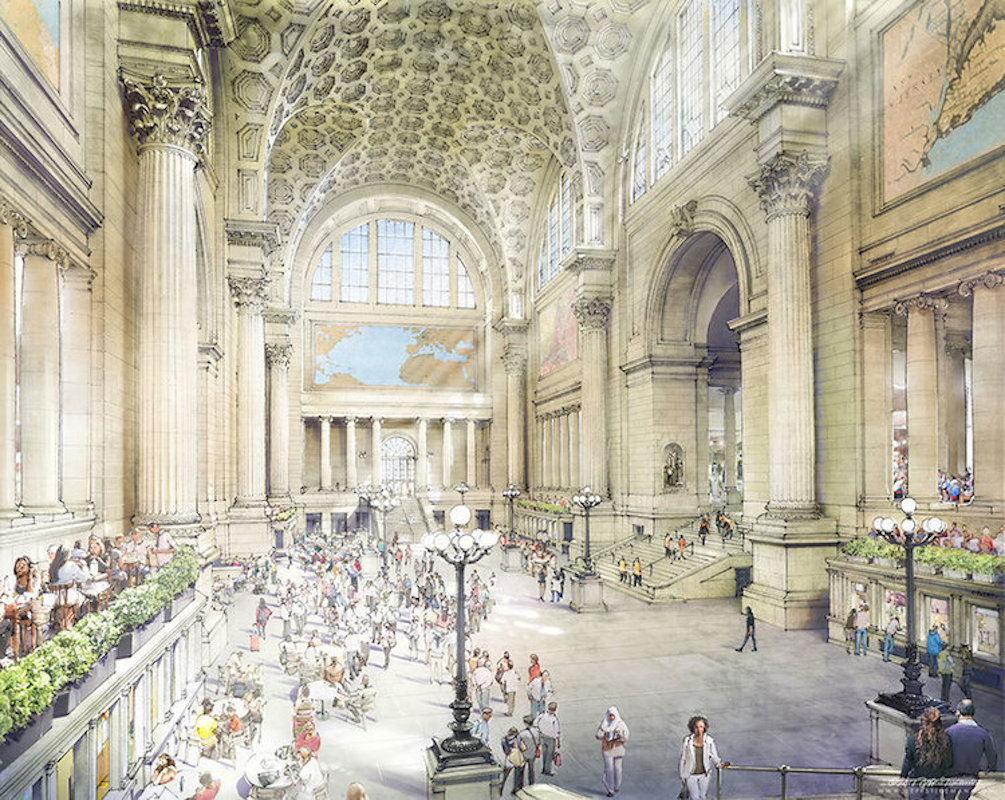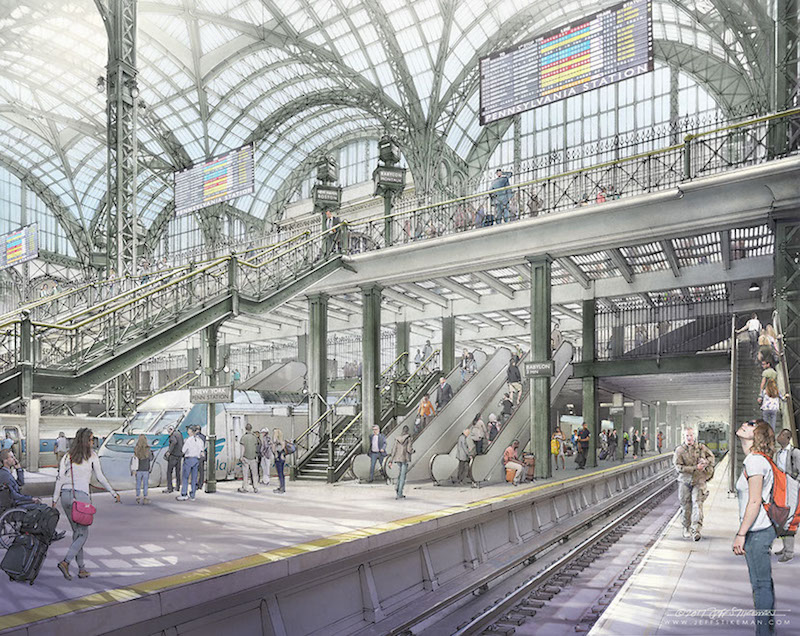 Rebuilt concourse with widened platforms and tripled escalators. Image by Jeff Stikeman for Rebuild Penn Station.
Rebuilt concourse with widened platforms and tripled escalators. Image by Jeff Stikeman for Rebuild Penn Station.
When the original Penn Station was demolished in 1963, it was considered an act of civic vandalism. The stunning station was replaced by today’s dark, dingy, and dangerous alternative, which takes in passengers of the LIRR, Amtrak, New York City subway, and the New Jersey Transit. While renderings and ideas have been tossed around for what to replace the current structure with, this New Jersey Transit ad campaign seeks to reimagine if the original Penn Station were rebuilt in a project spearheaded by the Rebuild Penn Station, a project of the National Civic Art Society.
Learn more about the original Penn Station on our Remnants of Penn Station Walking Tour!
Tour of the Remnants of Penn Station
Vishaan Chakrabarti’s grand vision of a new Penn Station would launch the space into the future, but perhaps there’s something to be said about the possibility of rebuilding the original station that was once larger and grander than Grand Central Terminal– going back to a design we’re familiar with and know can exist there. What would it look like? Is a historic design possible? Either way, the Rebuild Penn Station renderings by Jeff Stikeman leave us amazed as they pose to commuters and travelers the ultimate question “Wouldn’t you rather arrive here?”
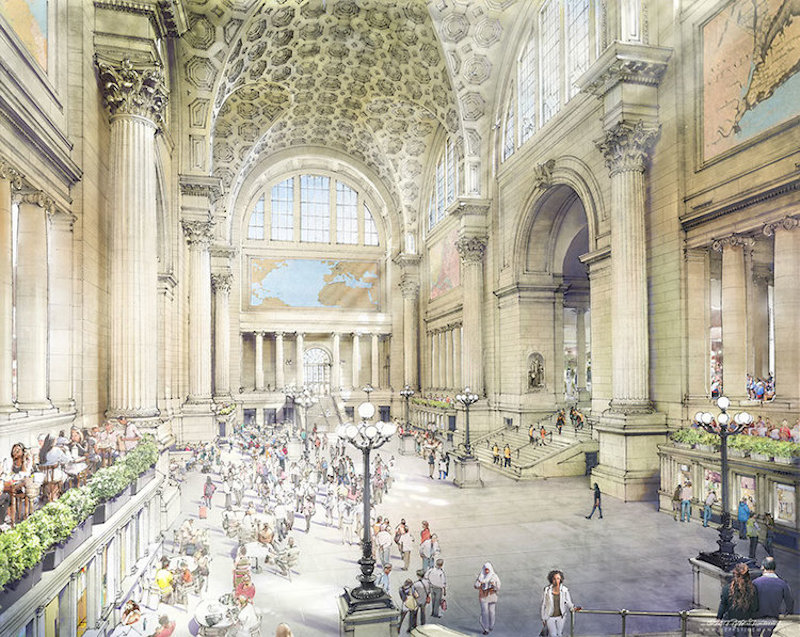 Rebuilt, improved main hall. Image by Jeff Stikeman for Rebuild Penn Station.
Rebuilt, improved main hall. Image by Jeff Stikeman for Rebuild Penn Station.
Honestly, we would rather be arriving here, too. In our efforts to bring to readers all the details of the lost station in our many articles and Tour of the Remnants of Penn Station, imaging the previous structure in images such as this is truly a sight for sore eyes.
Tour of the Remnants of Penn Station
The ad campaign urges commuters to support the rebuilding plan. Sam Turvey, chairperson of the Rebuild Penn Station Steering Committee said in a press release, “Today Penn Station is an ugly, cramped, and ineffective transit facility that is an embarrassment to the city and indeed all Americans. We propose rebuilding the station to bring back an architectural masterpiece, while simultaneously improving and updating the station’s functionality.”
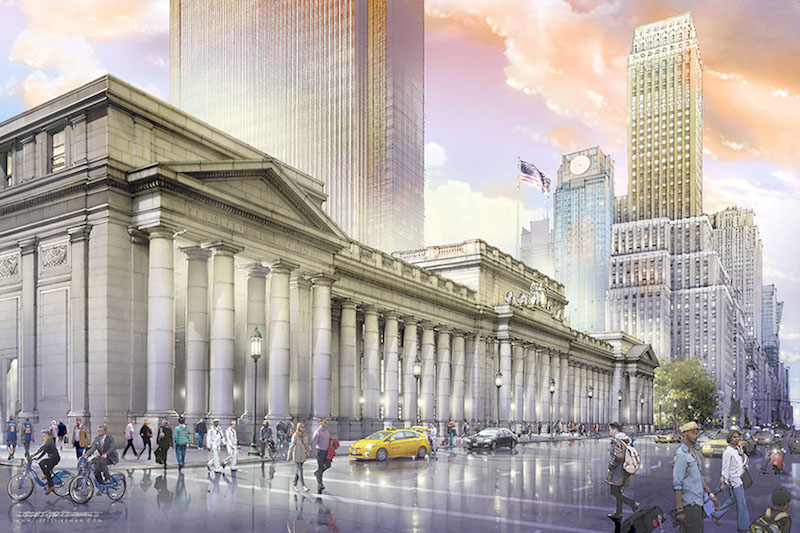 Rebuilt Seventh Avenue portico. Image by Jeff Stikeman for Rebuild Penn Station.
Rebuilt Seventh Avenue portico. Image by Jeff Stikeman for Rebuild Penn Station.
A project of this undertaking would cost an estimated $3 to $3.5 billion. That is a lot of money, but consider this: more people pass through Penn Station daily than LaGuardia, JFK, and Newark Airports combined, and $4 billion alone is going towards razing and rebuilding LaGuardia. The problem of Penn Station shouldn’t be ignored anymore nor dealt with as slowly it already is.
Rebuild Penn Station believes there project will not only handle today’s transportation needs, but that the reconstruction of the historic design will also “right a historic wrong, connect us to the best of our past, and provide millions of visitors and travelers with magnificent architectural experience for generations to come.”
The plans for a new train hall in the Farley Post Office building broke ground this past August, but this project would only take care of a small number of issues, serving mainly Amtrak users, and a single LIRR concourse. The bulk of LIRR traffic and the entire New Jersey Transit traffic would continue to come into the battered Penn Station below Madison Square Garden.
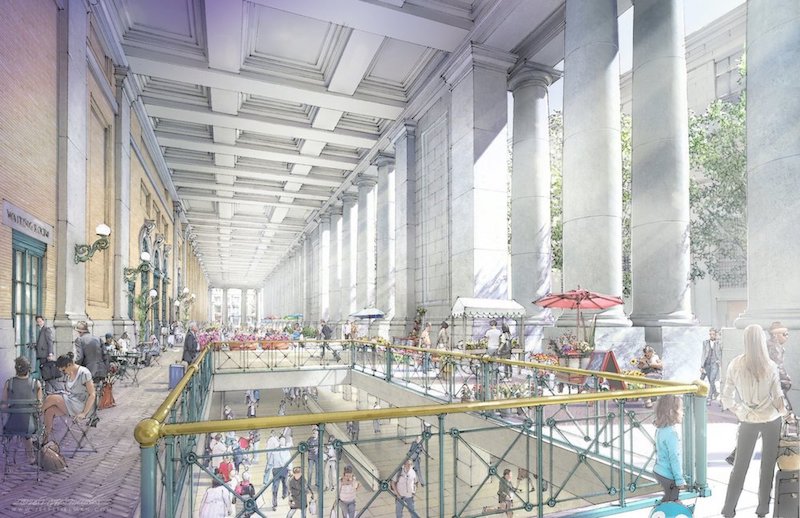 New covered arcades and pedestrian ramps on 31st and 33rd Streets. Image by Jeff Stikeman for Rebuild Penn Station.
New covered arcades and pedestrian ramps on 31st and 33rd Streets. Image by Jeff Stikeman for Rebuild Penn Station.
The sports arena is suffocating Penn Station, the busiest rail station in the country. Madison Square Garden has moved three times in its history already so there’s no reason it shouldn’t be able to move, or at least understand that it’s hurting to stay there more than its helping.
Recently, in a talk with Jill Jonnes at the Museum of the City of New York, Vishaan Chakrabarti explained that not only has the station suffered, but the surrounding area has as well. It is unattractive and unpopular, serving only as a commuting point for LIRR and Amtrak passengers to get to Grand Central Terminal, an area where Metro-North passengers are easily able to take a train in and walk to work because of the popularity of the area for business.
$4 billion was spent building the World Trade Center Transportation Hub, to rehabilitate the Financial District after the attacks on 9/11. The pristine white station serves the area well, driving in money from visiting tourists and providing a light-filled atmosphere for subway and PATH train commuters.
New Yorkers are frustrated with the decaying tracks (and the “Summer of Hell” it wrought upon us) and the oppressive atmosphere of Penn Station. How possible a project like Rebuild Penn Station’s is is always a question. But one thing’s for sure, be it Chakrabarti’s plan to build the Oculus of Chelsea or bring back to life the original station, something has to be done- and soon. After all, wouldn’t you rather arrive anywhere else other than the dilapidated station we currently use?
Learn more about the original Penn Station on our Remnants of Penn Station Walking Tour!
Tour of the Remnants of Penn Station
Next, check out What Penn Station May Look like in 2020 and be sure to see where to find 5 Remnants of the Original Penn Station in NYC.






